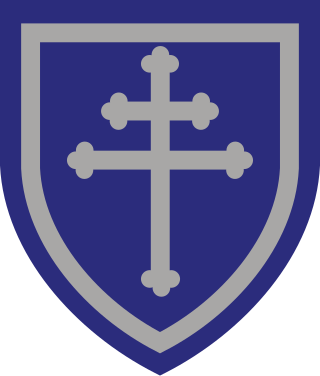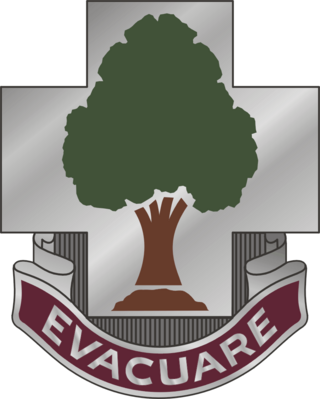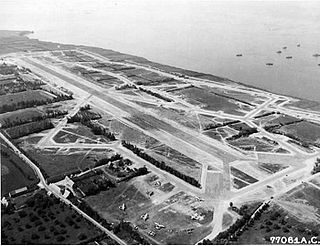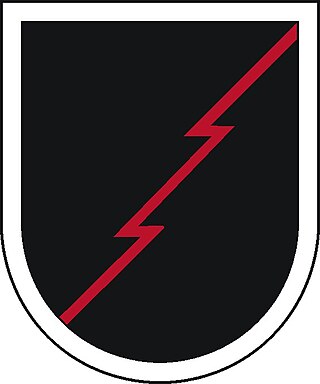Related Research Articles

The 4th Armored Division was an armored division of the United States Army that earned distinction while spearheading General Patton's Third Army in the European theater of World War II.

The 6th Armored Division was an armored division of the United States Army during World War II. It was formed with a cadre from the 2nd Armored Division.

The 11th Armored Division was a division of the United States Army in World War II. It was activated on 15 August 1942 at Camp Polk, Louisiana and moved on 24 June 1943 for the Louisiana Maneuvers. Transferred then to Camp Barkeley, Texas on 5 September 1943, the division participated, beginning 29 October 1943, in the California Maneuvers and arrived at Camp Cooke California on 11 February 1944. The division staged at Camp Kilmer, New Jersey from 16 to 29 September 1944 until departing New York Port of Embarkation on 29 September 1944, arriving in England on 11 October 1944.

The 5th Infantry Division (Mechanized)—nicknamed the "Red Diamond", or the "Red Devils" —was an infantry division of the United States Army that served in World War I, World War II and the Vietnam War, and with NATO and the U.S. Army III Corps. It was inactivated on 24 November 1992 and reflagged as the 2nd Armored Division.

A Combat Support Hospital is a type of modern United States Army field hospital. The CSH is transportable by aircraft and trucks and is normally delivered to the Corps Support Area in standard military-owned demountable containers (MILVAN) cargo containers. Once transported, it is assembled by the staff into a tent hospital to treat patients. Depending upon the operational environment, a CSH might also treat civilians and wounded enemy soldiers. The CSH is the successor to the Mobile Army Surgical Hospital (MASH).

The 79th Infantry Division was an infantry formation of the United States Army Reserve in World Wars I and II.

The 96th Sustainment Brigade, is a combat service support formation of the United States Army Reserve. It traces its history to the 96th Infantry Division which served in the Asia-Pacific theater during World War II. Effective 17 September 2008, the unit became the 96th Sustainment Brigade, with its headquarters located at Fort Douglas, Salt Lake City, Utah.

The New York Port of Embarkation (NYPOE) was a United States Army command responsible for the movement of troops and supplies from the United States to overseas commands. The command had facilities in New York and New Jersey, roughly covering the extent of today's Port of New York and New Jersey, as well as ports in other cities as sub-ports under its direct command. During World War I, when it was originally known as the Hoboken Port of Embarkation with headquarters in seized Hamburg America Line facilities in Hoboken, New Jersey, the Quartermaster Corps had responsibility. The sub-ports were at Boston, Baltimore, Philadelphia and the Canadian ports of Halifax, Montreal and St. Johns. The World War I port of embarkation was disestablished, seized and requisitioned facilities returned or sold and operations consolidated at the new army terminal in Brooklyn. Between the wars reduced operations continued the core concepts of a port of embarkation and as the home port of Atlantic army ships. With war in Europe the army revived the formal New York Port of Embarkation command with the New York port, the only Atlantic port of embarkation, taking a lead in developing concepts for operations.

Major General Raymond Oscar "Tubby" Barton was a career officer in the United States Army and combat commander in World War I and World War II. As commander of the 4th Infantry Division during World War II, most notably during the Normandy landings in June 1944, Barton is one of only eleven U.S. Army general officers who commanded their divisions for the duration of their combat service. He commanded the 4th Infantry Division from 3 July 1942 to 26 December 1944 and led them into battle from D-Day at Utah Beach, to the Battle of Normandy, the Liberation of Paris, and into the Battle of Hürtgen Forest before leaving the command due to health problems on December 27, 1944.

The 17th Field Artillery Brigade, "America's Premier HIMARS Brigade", is an artillery brigade in the United States Army. It is currently based in Joint Base Lewis McChord Washington as Force Fires Headquarters for I Corps.

The 15th Field Hospital is a field hospital of the United States Army formed in 1917 and perpetuated until today. The hospital has participated in World War I, World War II, Desert Storm, Operation Iraqi Freedom and Operation Enduring Freedom (Afghanistan). As of March 2019, the 15th Combat Support Hospital reorganized and re-designated as a field hospital and is now a component unit of the 32d Hospital Center.

The Engineer Special Brigades were brigade-sized amphibious forces of the United States Army developed during World War II and active from 1942 to 1955. Initially designated engineer amphibian brigades, they were redesignated engineer special brigades in 1943. The 1st, 5th, and 6th Engineer Special Brigades were assigned to the European Theater of Operations. The 1st Engineer Special Brigade participated in the landings in Sicily and Italy before joining the 5th and 6th Engineer Special Brigades for the invasion of Normandy.

This article incorporates public domain material from websites or documents of the United States Army.

Saint-Pierre-du-Mont Airfield is an abandoned World War II military airfield which is located in the Calvados department in the Normandy region in northern France. It was one of the many instrumental airfields used to defeat Adolf Hitler's Axis powers in World War II.

The 735th Bombardment Squadron is a former United States Army Air Forces unit. It was assigned to the 453d Bombardment Group and last stationed at Fort Dix Army Air Base, New Jersey, where it was inactivated on 12 September 1945. The squadron was first activated in May 1943. After training in the United States with the Consolidated B-24 Liberator, the squadron deployed to the European Theater of Operations, participating in the strategic bombing campaign against Germany. Following V-E Day, the squadron returned to the United States for conversion as a very heavy bomber unit, but inactivated instead.
The 95th Evacuation Hospital was a U.S. military hospital during World War II, the Vietnam War, and in Germany.

The 274th Forward Surgical Team (Airborne)—part of the 274th Forward Resuscitative and Surgical Detachment (Airborne)—is an airborne forward surgical team of the United States Army providing Level II care far forward on the battlefield. It was first constituted in 1944 and served in Europe during World War II. More recently it has been involved in relief operations following natural disasters and has undertaken several recent deployments to Iraq and Afghanistan. The 274th Forward Surgical Team was part of both the initial entry forces of Operation Enduring Freedom in 2001 and Operation Iraqi Freedom in 2003. Currently the unit falls under the command of the 28th Combat Support Hospital and is based at Fort Bragg, North Carolina.

The 1st Engineer Brigade is a military engineering training brigade of the United States Army subordinate to the United States Army Engineer School. It is headquartered at Fort Leonard Wood, Missouri.

The 261st Medical Battalion is a Multifunctional Medical Battalion of the US Army located at Fort Bragg, North Carolina, under the command and control of the 44th Medical Brigade. It provides a flexible and modular medical battle command, administrative assistance, logistical support, and technical supervision capability for assigned and attached medical organizations, which can be task-organized to support deployed forces.
References
- 1 2 3 4 5 6 Montbertrand 2014.
- ↑ "The 203rd General Hospital" . Retrieved 20 January 2021.